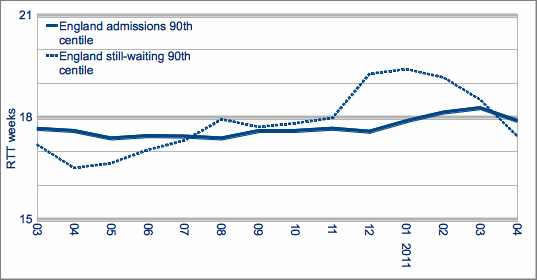DH sweeps long-waits under the carpet
11/07/2011by Rob Findlay
The Deputy NHS Chief Executive of England, David Flory, has written a stern letter to all NHS Chief Executives:
The commitment to ensure patients receive treatment within 18 weeks of referral is embedded in the NHS Constitution and is a fundamental part of the NHS Contract. The Government has recently reinforced this commitment. I have personally stressed the need to maintain delivery of RTT through the meetings that were held with you to “sign off” plans for 2011/12. There can, be no doubt about the importance of delivering improved performance on waiting times, particularly for admitted patients.
Stirring stuff. But then he goes and spoils it:
Against this background, it is unacceptable for performance to fall below the expected standards as it did in February and March 2011.
But February and March were the months when the NHS sorted out its long-wait backlog. Here’s the chart:

Watch the dotted line; it shows what’s happening to the waiting list backlog. Back in November, one in ten patients on the waiting list were waiting more than 18 weeks since referral. Then winter struck, the backlog grew, and at the end of January one in ten were over 19.4 weeks. Then in February and March the NHS sorted the problem out, admitting the longest-waiters and cutting the backlog down to pre-winter levels.
But the Department of Health weren’t watching the dotted line. They were watching the solid line instead. This shows the waiting times of the top 10 per cent of patients who were admitted. Clearing the long-wait backlog meant admitting lots of long-waiters, so in February and March the solid line went up, breaching the 18 week target level.
When, in all this, was the performance “unacceptable”? Surely not when the problem was being solved, in February and March? The worst performance was surely in December and January, when the backlog was allowed to grow? This letter is starting not to make sense.
And it goes on:
Recovery plans for the worst performing organisations were requested during the recent planning round. … I expect local support to be made available; contract levers to be applied in a robust way and for swift intervention where the necessary progress is not being made.
The “contract levers” he refers to are in the standard NHS contract. They include Schedule 3, Part 1, section 8, which provides for heavy financial penalties if Trusts admit too many long-waiters. So if a Trust has developed a long-wait problem, it isn’t allowed to tackle it by admitting lots of long-waiters. That’s like trying to solve over-indebtedness by limiting how fast people are allowed pay off their loans.
Surely the Deputy Chief Executive of the NHS in England cannot be encouraging Trusts to sweep their long-waiters under the carpet and ignore them? That would be truly astonishing, and yet… well, here is another shred of evidence.
On the very day he sent his letter, David Flory also published his report “The Quarter” which covers the same time period. On page 19 he lists the twenty-eight “Acute trusts with poorest performance on referral to treatment waits March 2011”.
There is a strange omission from this list of 28 recalcitrants. It is the Trust with the second-longest-waiting patients in England. At the end of March, 31 per cent of its waiting list patients were over 18 weeks, and 5 per cent were over a year. So how on earth did it escape the list? The answer is, this Trust wasn’t tackling its backlog. In March, only 5 per cent of its admissions were over-18-week waiters. That meant it achieved the headline target, and escaped the list of sinners.
Which Trust is it? It’s University College London Hospitals NHS Foundation Trust: the hospital where David Cameron promised not to lose control of NHS waiting times, just a few short weeks ago. If the Department of Health wants to encourage Trusts to neglect their longest-waiting patients, it is going the right way about it.
Return to Post Index